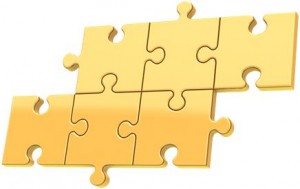 It seems that some people are better than others at figuring out what to do when presented with a new challenge.
It seems that some people are better than others at figuring out what to do when presented with a new challenge.
Every day we are all presented with new challenges – c’est la vie – and for one challenge some of us seem to know what to do and others of us are left scratching our heads.
Yet, when presented with a different challenge the tables are turned.
Why is that?
Until recently I believed that improvement was just a matter of accumulating enough knowledge and experience – but the pattern seems to be evident in people of all ages and experience: there seems to be more to it than just experience.
So, I searched the Internet on the topic of “problem solving” and many of the references mentioned the word “intelligence” – a word that generates mixed feelings for me.
My mixed feelings came from an experience I had as a student. I am, by nature, both competitive and curious and I felt it would be useful to know my IQ and to meet others who shared my curiosity – so I did the Mensa test. I “passed” and was duly invited to a get-together at a local pub and was informed that I only needed to look for the distinctive yellow magazine to identify the meeting table (mensa is latin for table). I did not need the magazine to identify the table of Mensans and after that first encounter I chose not to return. I had a sense that there was something missing – high IQ was not enough – and it was that “something” I was looking for.
I now know that mixed feelings are often a symptom of an over-simplification; a signpost to a deeper awareness; and a hint to keep digging for the deeper meaning. Here is a definition of the word “intelligence” that I found on Wikipedia:
“Intelligence: A very general mental capability that, among other things, involves the ability to reason, plan, solve problems, think abstractly, comprehend complex ideas, learn quickly and learn from experience. It is not merely book learning, a narrow academic skill, or test-taking smarts. Rather, it reflects a broader and deeper capability for comprehending our surroundings—”catching on,” “making sense” of things, or “figuring out” what to do.
This definition resonates and prompted a question:
“Are there more forms of intelligence than the ones we are familiar with in the Mensa-style Intelligence Quotient (IQ) tests? And if so, how many forms of intelligence are there and what are their characteristics?”
My intuition said “Yes – there are more than one” and I had the sense that are at least two forms; one that is conscious and that deals with quantities – so I labelled that as quantity-intelligence or quantigence; and another that is unconscious and deals with qualities – so I labelled that as quality-intelligence or qualigence.
It also felt that these are not independent of each other – they do not feel like two separate dimensions – they feel like two views of the same thing. It just did not feel right that we might be observed, measured and scored on independent IQ scales and then classifed, arranged, ranked, selected, compared, and improved; it feels more dynamic than that.
Perhaps it is how well we are able to employ the multiple forms of IQ in a dynamic and synergistic way to figure out what to do more easily, more quickly and more often.
But what does all this have to do with Improvement Science?
Well because improvement only happens after we figure out what to do and then we actually do it. Both diagnosis and treatment are necessary and the sequence order is important – treatment before diagnosis carries a greater risk of unintended consequences – and unintended consequences are usually negative.
Challenges that require a balance of qualigence and quantigence at the diagnosis stage will appear “tougher” to solve and siuch challenges will tend to accumulate as a list of long-standing, unsolved and unspoken niggles – like a veritable herd of emotional elephants in the room.
This niggle-mine seems to be where the greatest opportunities for improvement are buried – nuggets of new knowledge waiting to be uncovered.
How then do we know if we have a qualigence-quantigence gap?
I concluded that if we are continually struggling with the same old problems; are spending a lot of effort, time, and money; and are not making progress then we can be sure we have a gap somewhere. The questions are “what, where and how to convert our niggles into nuggets – our weaknesses into strengths?”.
It would appear that we need three ingredients – qualigence, quantigence, and an ability to dynamically integrate them into something that is even greater than the sum of the parts – something we might call synergy-intelligence or synergence.
To test this idea I searched the Internet for the word “synergence” and found many hits that resonated with this concept. Good.
Our next step might be to look more closely at the three ingredients and to ask:
- Q1. What would I need to diagnose and treat a quantigence gap?
- Q2. What would I need to diagnose and treat a qualigence gap?
- Q3. What would I need to diagnose and treat a synergence gap?
These are powerful questions.
 Ignorance means “not knowing” and as the saying goes “Ignorance is bliss” because we do not worry about what we do not know about. Or do we?
Ignorance means “not knowing” and as the saying goes “Ignorance is bliss” because we do not worry about what we do not know about. Or do we?


